Public transport & How to get around Vienna
I would like to share with you some information regarding the public transport and other means of moving around Vienna and my own impressions and thoughts of using it so far.
Place where you can use (almost) everything to move around
I didn't know how to start this actually but since there are lots of ways to get around the city I'd start with explanation of this title. To understand more my impressions of the life and opportunities here just don't forget that I come from Zagreb where there are only tram and bus lines, bike routes are like the Nazguls (neither living nor dead) and train is used only by the people who come to work but living almost out of the city. And now Vienna.
Regarding the public transport in Vienna you can use:
- the metro (Ubahn)
- the trams
- the buses
- the train within the city area
- citybike
But that's not all of it! What you will notice is that the city has (I'd say) perfectly organized bike routes in the streets. There are roads and tracks especially built for the cyclists and you can feel safe using them. And the tracks don't just bump into a building or some obstacle (unlike in Zagreb). Even on the road among the cars (usually the tracks are near the pedestrian path) I never had fear that I'd get overrun or hit by a car. Seems that people respect the rules here. Pedestrians in general never walk on the bike path. Lots of Viennese use their bikes everyday. There is also this great service called CityBike. More about it later.
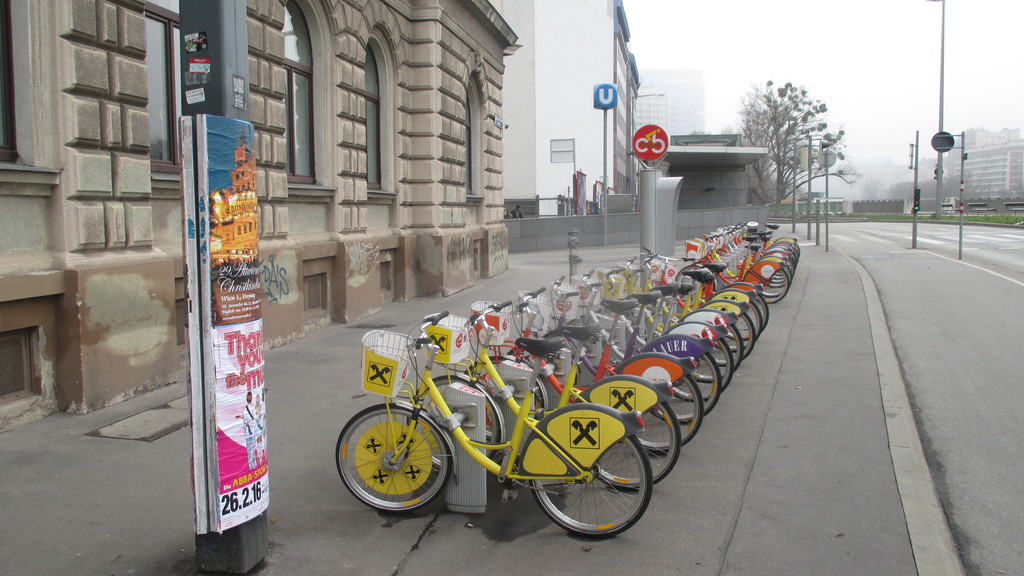
Another thing I've noticed for the first time in Vienna is that people use a lot the scooters. And not only children but adults. It was very strange and honestly a bit funny to see the lawyers, old ladies and the others to run on the scooter! We don't have it at home so it is a bit exotic. But why are they so popular? The thing is - the bikes should be according to the law on the bike paths... but... the scooters are not in the same category but seen and regarded as 'pedestrians'. That means you can go anywhere with your scooter without fearing the police. And they might be more flexible, you can fold them and take where you need. I haven't had a chance to use one, I hope to do it before I leave for Croatia, just to have this awesome feel. haha
- Now before I say a bit of every type of public transport, I suggest you to check this awesome website and a great tool that you will be using for sure during your stay in Vienna! You can find there all the info of the public transport and more important - you can get very precise information on how to get from A to B telling you time, directions, where to walk... everything!
Now let's start with a bit info of every mean of transportation
Offers and prices that matter to students.
If you're studying here, doing an internship or something third the whole semester or a few months, I bet you want to know the most affordable way to use the public transport. There are few options:
- Vienna Semester Ticket (150 €)
-winter semester from 1 September to 31 January
-summer semester from 1 February to 30 June
-you need to be under 26 and have a valid ID card showing that you're a student at Uni Wien
- Annual Ticket
This could be a good alternative if the first plan doesn't work as apparently each ticket will cost you € 365 (1 per day) and you can stop this activity any time you want. Unfortunately for me it was not good explained for me when I asked for the information, might have been more affordable than buying monthly tickets
- Monthly and Weekly Tickets
-
the prices of the monthly ticket is € 48. 20 and of the weekly € 16. 20- pay attention - the weekly tickets are valid from the first day of the week (Monday) from 12am till the next one until 9am... and the monthly from the first day of the month till the 2nd of the next one
- 24 / 48 / 72 hours TIckets
- the prices are € 7. 60 / 13. 30 / 16. 50
All of these tickets are valid within the zone 100 or simply within the city (where you see the trams, buses, ubahn but also the train within the city! )
If you want to buy a single ticket which costs €2. 20 with also unlimited rides/changes but only within one zone where you got it....
And lastly - I recommend you to simply buy the ticket at the machine at the station. You can use cash and also electronic cards. Don't forget to pick up your card after you pay!
Since I don't study here but only do the internship thus my student status in Vienna is... non existing.... I'm buying monthly tickets and fully use and enjoy the comfort of the public transport.
1) The Metro (Ubahn)

[Click here for the PDF version]
Probably the most popular mean of transportation for the majority of the citizens. The first lines where already opened at the end of the 19th century! There are five lines that connect the corners of the city and I would call it the aorta of Vienna. It gets you practically everywhere and the majority of the destinations you have to reach are mostly likely close to one of the U-station, within 5-15 minutes walking by foot. That doesn't sound bad, does it?
Another thing that's great is that if you are ever feeling lost in the city once you see the U-sign you will stop worrying. I remember my two times in Vienna that after not knowing anything about the location where I stood or how much does it take to go somewhere.. once you see the sign it's all clear.
Compared to other public transport it is just so easy and fast to go somewhere by using the metro lines. For example, if you arrive by bus at the Stadion or Erdberg bus station which are close to the Danube, once you enter the U-bahn you'll be near the City Hall and the University in 10-15 minutes max! That's around 7-8 kilometers with 5-7 stops. Sometimes I forget that I'm not using the trams and that you can reach most of the places around the center within 10-15 minutes.
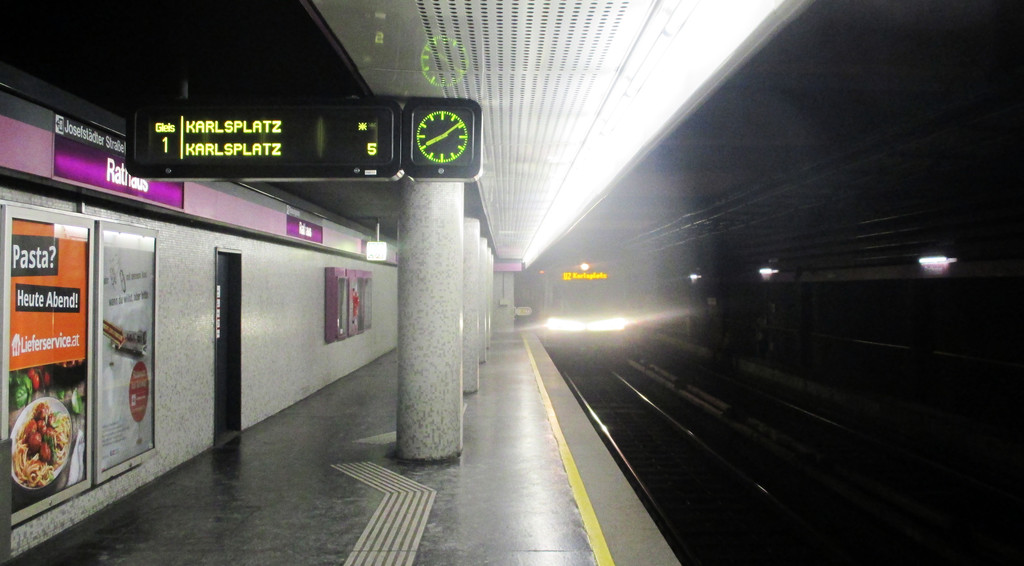
The biggest one is the station Karlsplatz where you can choose to go to 3 lines and it's probably the most crowded one (along with the railway stations where it's also a crossing between 2 lines).
The U-Bahn is available:
- Mon-Fri the first lines start at 5am and the last at 0:15am so be careful when planning your trips as after that you'll be able to use only the bus night lines
- on Fri/Sat and Sat/Sun they are available whole night driving in shifts of 15 minutes. That is not so bad, especially if you plan to go out and have to return before 5am.
Are the metro trains clean?
I got asked this a lot by my friends from other countries. Yes, the metro is pretty clean, never had any problem or uncomfortable situation that something was smelling or was dirty. I might have seen a drunk guy inside so everyone was just forced to smell him (those poor souls close to him haha). In general I believe it's mostly to the manners of the citizens, I cannot imagine anyone here doing dirty stuff or anything against the rules of behaviour in the metro. The seats are comfortable and there are two kinds of metros so far that I've encountered with slightly different organization of the seats. Also, at the end of every stop the passengers are kindly asked to leave the train. I guess during the rotation they check it quickly if there's something wrong.
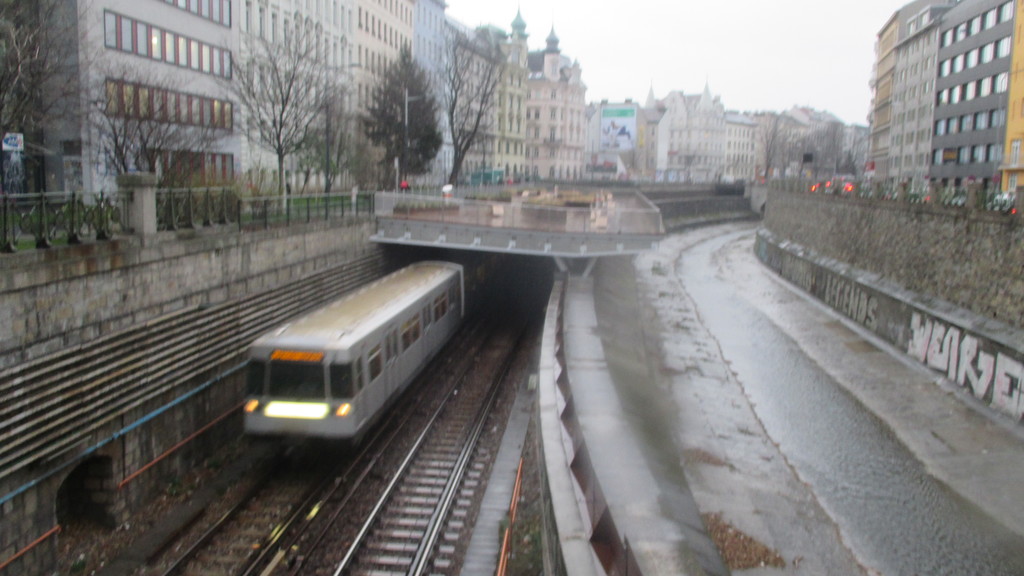
Enjoy the urban landscape with the line U6
Yes, while mostly it surely is 'the underground', if you take a ride on U6 from the Meidling in the direction of Florisdorf you will have an opportunity to see Vienna from above for several stations. It looks amazing! There is 'a dam' built from stone and iron that is probably hundred years old (even more awesome! ) that goes through the western part of the city (still the historical districts). Highly recommended.
2) The buses
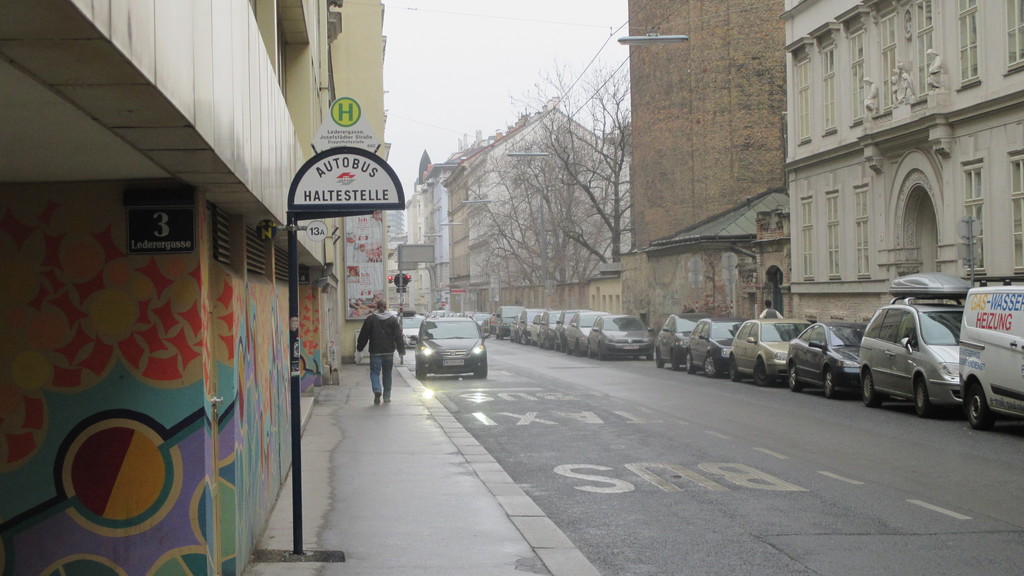
The buses are as well very popular, I think I see even more people using them rather then the trams. There is a big number of lines that go literally like snakes from the game around the streets. In contrast to Zagreb where it's flat terrain more or less (except for the Upper Town) there aren't that many changes of direction. Here it's like every few streets it goes left, right, up, then makes a circle... I was lost first few days trying to remember my location in the head... number 13a was driving me crazy, especially around Mariahilfer Straße...
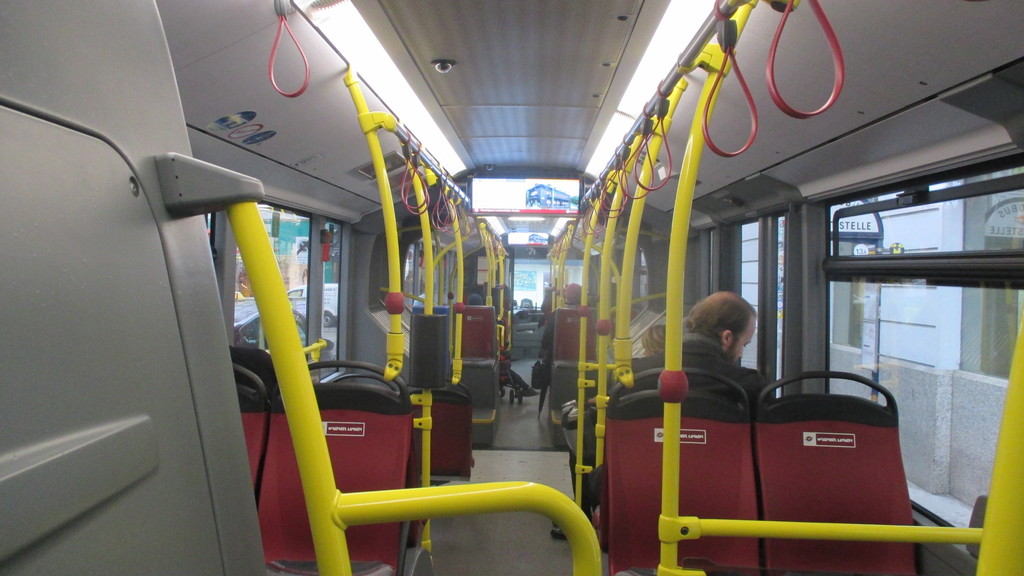
But that's what's the "thing" here... to feel how the city was built on numerous small hills you have to take a bus to go up and down the streets. With trams it's not the same. The buses are pretty comfortable. They all have 2 entrances for the parents with the baby carrier and places usually reserved for the pregnant women, the elderly and weak. Seats can be also pulled down at this part in front of the doors where the parents with carrier come. It's used by the elderly people mostly.
The buses time between the two same lines at the bus station is around 3-7 minutes, depending on the traffic. And all the bus and tram (as well as Ubahn) stations have a loud speaker which tells you the news in German (and English if it's more important) which mostly have this message "Dear passengers, the line XY is driving irregularly today, thank you for your understanding".
Since numerous streets in Vienna are suitable for a drive in only direction you should pay attention that the same line won't go the same way from the location A to B and B to A but rather use nearby streets. They will also have different names for the station so be careful (I forgot on my way home where I needed to leave the bus haha).
The single price for the buses and trams is € 2. 30.
Buses will also save you and bring you home or to desired destination after 1am during the working days. There are night lines that go around the city while metro and trams are sleeping. Again, don't forget the WienerLinien.at website to check your routes!
Learn German with the public transport!
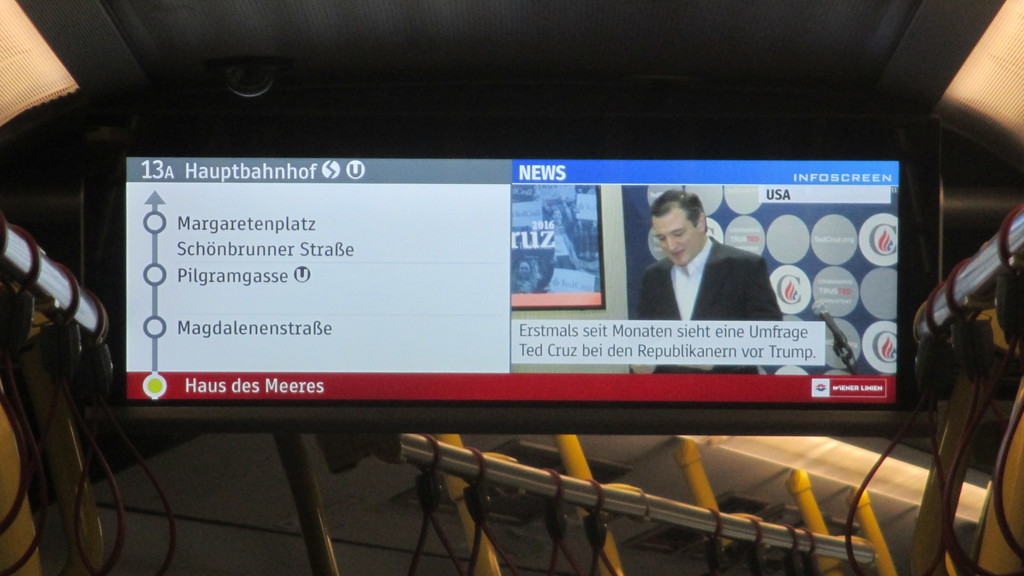
Sounds crazy? Actually it's not only me who finds this to be a very good way to practice your German. You see, in every bus and tram there are 2-3 screens with two sides. The left side is there to show you the line (and thus you will always see 3-4 stations ahead) and the right shows the advertisment and the news. We don't have this in Croatia so I really enjoy the rides since I have mostly nothing else to do and can follow the news and learn vocabulary.
I recommend you as well to check the display. The most useful are of course the news with a few sentences. The rest is mostly advertisement related to the cinema, games and some editorials. There's also a quiz.
And that's not all. At practically every entrance to the U-Bahn station you can find a box with the free newspapers (for example, Heute). Just take them. Another good material to learn German and expand your vocabulary. Also you might find coupons for McDonalds, Burger King or some other normal restaurants.
And in the metro itself there are some magazines below the windows. But I doubt you'll ever read them. I have only seen two people doing it, some guy who might have been a tourists. And me.
3) The trams

Naturally, there is also plenty of tram lines that go just through the streets very much like buses - going like a snake up, down, right, left at every corner. Especially outside the 1st District or in the south you can get lost.
There are two types of the trams that you will find. The modern looking ones and those that seem to be 'an older edition'. I personally like the old ones more while the organization of the space and the seats is much better. The modern ones are more suitable for the parents with children and baby carrier. They are also at the ground level whereas the old ones have 2-3 stairs to climb on.
There is one particular thing that I have seen for the first time in Vienna, regarding the tram station. It's not about the network that goes like snake between the streets. It's that at some tram station you have to wait on the road in front of the car to enter the tram. At first I thought I was crazy and that I will get killed. But that's not how the things are working here obviously. When there is a tram arriving at the station all cars have to stop regardless of the green or red traffic light. And the road in front of the tram's gates is a bit heightened or elevated.
The interval between the arrivals of the two lines seems to be a bit longer than it's the case with the buses. Trams come one after another in general every 5-10 minutes. On weekends both buses and trams seem to be operating not that actively as during the working days and you have to wait more. Especially for some tram lines more than 10 minutes waiting can be a rule. Rather take a walk. Especially when there are lots of stations every 2-3 minutes walking.
4) The train network
With the WienerLinien tickets (especially those over 24h) you can use the trains within city's area. I don't know much about this to be honest since I have never had a need to use the train. You can find more info at the train station.
5) CityBike
Now this is a very useful tool if you're planning to discover Vienna by bike and don't have your own. Or you simply want to go to other parts of the city without using the other means of public transportation. Look at it as a free gift from the city (as they say "Die Stadt gehört Dir").
Some fun facts that might be of interest to you. The first hour of every ride is free. Then you will pay another hour € 1. But if you leave the bike at some station (you don't have to go back to yours), wait for 15 minutes and take another bike: The time restarts and with the new bike you have again the right to use it for free within 60 minutes. That's what I mostly did. I used the citybike around 5-6 times and if I felt like going around the district I would just leave it at some stationary few minutes before I would have to pay for it... walked to another one and waited few more minutes and all over again.
To use the bikes you first need to do a one-time registration. That can be done online or at the automat at the bike stationary. You create your account with username and password that you will need to confirm everytime you want to use the service. It costs € 1.
There are around 120 bike station in Vienna. The good thing is that you can find them near all the important places and it takes less than 10 minutes walking to find another one, especially around the districts in the center. The problem is yet that there are still non in the south of the Main railway station (Margaretengürtel & Hauptbahnhof).
There are 3 options for the speed and to slow down or stop you can simply use the left brake or even start paddling backwards which will automatically try to stop the bike. It might take a bit to get used to it. The bike also have a basket which can be pretty useful if you have a handbag or backpack or just want to put away the bags from the shopping.
Regarding the free hours, you have right to use up to 120 free hours a year. Then... I don't know... But I guess that if you plan to use the bike that much you'll be likely going to buy one for yourself. Though 120 hours seems to be a pretty good deal after all. And you have the nice bike tracks all around the town.
The problems might occur if you want to leave bike somewhere, especially if it's urgent, and then you find out that there are no more free places to leave the vehicle. What to do?
I recommend you to download some of the smartphone apps that will help you find with providing useful information of all the bike stationeries in Vienna. You can simply check the list or the map of the closest stationeries as well as the availability. Thus you have nothing to worry about. The application I use is Citybike Wien available here.
And that's it folks
In conclusion, I think that the transport in Vienna is very well organized and serves its purpose to the citizens. The biggest treasure without the city wouldn't normally function is the underground which is great because it doesn't depend on the weather and is fast. And the city is bike-friendly, as my friends also noticed there aren't that many cars, you probably don't need them thanks to everything else.
Photo gallery
Content available in other languages
Want to have your own Erasmus blog?
If you are experiencing living abroad, you're an avid traveller or want to promote the city where you live... create your own blog and share your adventures!
I want to create my Erasmus blog! →























Comments (0 comments)